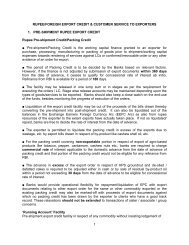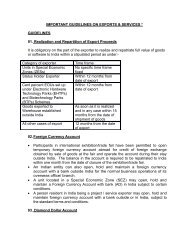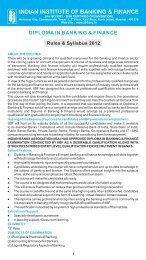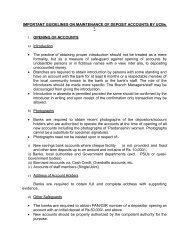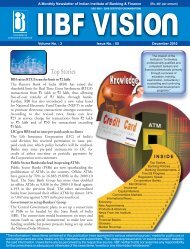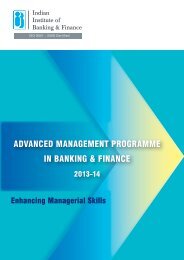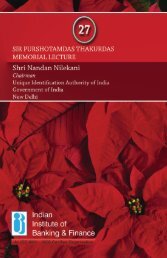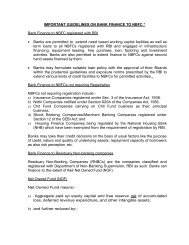Create successful ePaper yourself
Turn your PDF publications into a flip-book with our unique Google optimized e-Paper software.
special feature- Indian Banks Association : Performance Highlights of PublicSector Banks, Private Sector Banks, various issues- Kick, Thomas and Koetter, Michael (2007) “ Slippery Slopesof Success: Ordered Failure Events In German Banking”Discussion Paper, Series : 2, Banking and Financial Studies,No. 3/2007, Deutsche Bundesbank.- Kumbhakar, C. Subal and Sarkar, Subrata (2003), “Journal ofMoney, Credit and Banking, Vol - 35, No. 3.- Mittal M. and Dhade A.” Awareness and Perception of CAMELRating across Banks : Some Survey Evidence “The IcfaiUniversity Journal of Bank Management, Vol - VIII, No. 2, 2009,52-64.- Sathye, Milind (2005), “Privatization, Performance and Efficiency: A study of Indian Banks”, Vikalpa, Vol - 30 No. 1m, 7-16.- Shanmugam, K. R. and Dass, A. (2004), “Efficiency of IndianCommercial Banks during the reform period”, Applied FinancialEconomics, Vol 14, 681-686.- www.rbi.org.in, official website of Reserve Bank of India- RBI (2010), “Report on Trends and Progress of Banking in India”.ABBREVIATIONS :APPENDIXADVTA - Advances to Total Assets RatioBPE - Business Per EmployeeCAR - Capital Adequacy RatioDER - Debt Equity RatioGNPANA - Gross NPA to Net Advances RatioGSTI - Govt. Securities to Total Investment RatioIITI - Interest Income to total income RatioLATA - Liquid Assets to Total Assets RatioLATD - Liquid Assets to Total Deposits RatioNIITI - Non-Interest Income to total Income RatioNIM - Net Interest Margin (Spread) to Total Assets RatioNNPANA - Net NPA to Net Advances RatioNNPATA - Net NPA to Total Assets RatioNPA - Non- Performing AssetsOPAWF - Operating Profit To Average Working Funds RatioPATAA - Profit After Tax to Average Assets RatioPPE - Profit Per EmployeePSB - Public Sector BankPVTB - Private Sector BanksSCB - Scheduled Commercial BankTADVTD - Total Advances To Total Deposits RatioTITA - Total Investments to Total Assets RatioTypology of Conventional and Unconventional Measures of Central BanksMeasures Rationale InstrumentsI. Conventional1. Open Market Operations To achieve nominal anchor Repos, lending and Issuance of central bank bills.(OMOs) and StandingFacilities (SFs)2. Open market foreign To achieve nominal anchor or smooth Cash, swaps, derivatives.exchange operations exchange rates3. Direct instruments To complement OMOs and SFs Reserve requirements and credit ceilings.4. LOLR to institutions To ease financial conditions or market Discretionary lending.and marketsliquidity stressII. UnconventionalA. LiquidityEasing Measures1. Direct instruments in To improve monetary transmission and Reserve requirements and regulatory liquidity ratios.money marketsrestore market stability2. Systemic domestic To enhance monetary transmission Unlimited domestic liquidity provision, broadening theliquidity arrangements and restore market stability list of counterparties and easing collateral requirements.3. Securities liquidity To improve monetary transmission Exchange of illiquid for liquid securities.provisionand restore market stabilityB. Credit Easing To enhance monetary transmission Purchase of targeted private securities, direct creditMeasures and restore credit market functioning provision, provision of liquidity to investors in targetedsecurities.C. Quantitative To enable monetary transmission when the Unsterilised outright purchase of governmentEasing Measures policy rate approaches the zero lower bound securities and foreign exchange.D. Foreign ExchangeEasing Measures1. Foreign exchange To ease foreign exchange Unlimited liquidity provision, broadening of collateralliquidity injection liquidity pressures and counterparties.2. Cross-central bank currency To support national bank's foreign Swaps.swap arrangementsexchange operationsSource : Currency & Finance 2008-09, Reserve Bank of India (RBI).The Journal of Indian Institute of Banking & Finance October - December 2011 51



